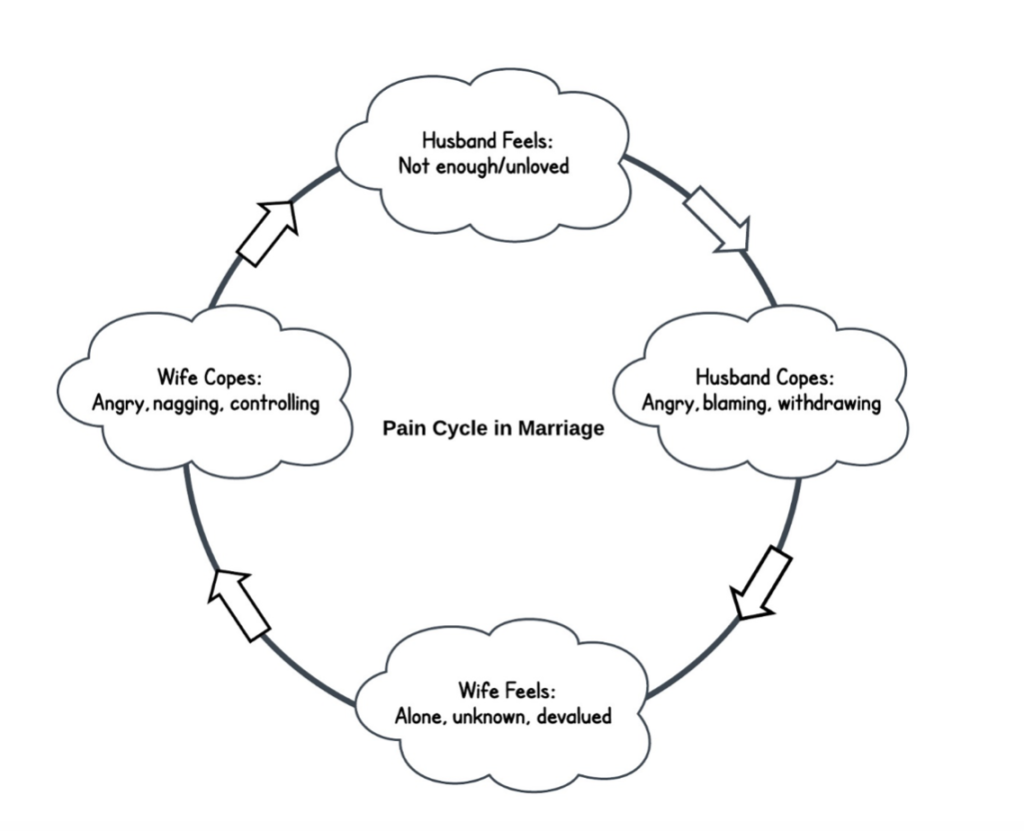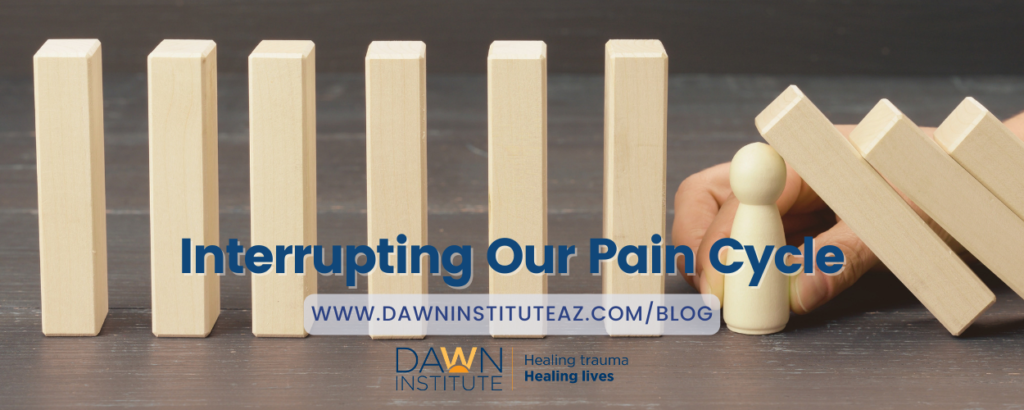Have you ever looked back on arguments and wondered why you react a certain way when dealing with conflict? Perhaps those closest to you have told you that that you’re controlling, you withdraw, or you explode and blame others when a conflict occurs. Maybe you’ve even lost relationships because of these patterns. Do you ever feel dysregulated or unable to manage your emotions? That you’re in a situation and don’t know why or what to do about it? The term for this pattern of dysregulation and unhealthy responses is called a Pain Cycle. By understanding our own Pain Cycle, we can identify destructive patterns of communication to promote positive change in ourselves. By interrupting our Pain Cycle, we can self-regulate and have healthy relationships.
What is a Pain Cycle?
The Pain Cycle is a construct of Dr. Terry Hargrave’s Restoration Therapy. The Pain Cycle is a pattern of feeling and coping that originates in injuries to our sense of identity or safety. When these injures affect our identity, they are violations of love. Violations to our sense of safety are violations of trust in some way. These violations become inaccurate messages we teach ourselves, received during our attachment journey, which have become unhealthy ways to cope. These messages we tell ourselves may come from childhood experiences with our family of origin. This is why building healthy attachment in our children is so important. They can also originate in significant relationships outside of our family (mentors, teachers, peers), as well as life situations and trauma.
These inaccurate messages reflect how we feel about ourselves and trigger our reactive and unhealthy coping skills. When our messages come from violations of love, the tendency is to cope through shaming ourselves (I’m such a terrible person!) or blaming others (If you weren’t involved this wouldn’t have happened!). If the violation comes from safety or trust, our tendency is to react by controlling the situation or other people (you aren’t doing it right…I’ll just do it myself) or withdrawing from those we are in relationship with (ghosting, not showing up for others). When we use these unhealthy coping skills, they tend to trigger other people’s Pain Cycles and the cycle grows and continues. Check out this example of how this can happen.
Pain Cycle Between a Husband and Wife:
Wife: Can you take out the garbage?
Husband: You are such a nag!
Wife: Maybe if you would take out the garbage, I wouldn’t have to be a nag!
(Husband leaves the room and slams the bedroom door)

Perhaps this husband had received a message in his childhood that he was not enough, centering around chores. Maybe he could never satisfy his parents and did feel loved if he did not do his chores. Maybe the wife received a message that she had to do tasks by herself in order to get them done. The wife may feel unseen, unappreciated, and very misunderstood. These messages unintentionally trigger individuals in relationships. Without mindful recognition from the person triggered, dysregulation causes them to cope in unhealthy ways learned over time. The cycle continues if they’re unaware of their triggers.
Interrupting and Overcoming Our Pain Cycle
We all have unhealthy coping patterns and inaccurate messages we believe about ourselves. Our feelings help us understand how we see ourselves and the world if we take the time to non-judgmentally process them. Becoming aware of these feelings and messages and processing the truth about them will help us have a better sense of identity, recognize when we are safe and can trust others and improve our relationships. By doing this we can interrupt our Pain Cycle by being mindful of when these destructive messages are triggered and replacing them with a Peace Cycle.
The Peace Cycle is another construct of Restoration Therapy that promotes self-regulation. The Peace Cycle comes from understanding the truth about ourselves, and choosing to behave differently out of that truth. By practicing peace, we make mindful decisions as adults to understand our own attachment injuries by processing our experiences and trauma. This way, we can understand and appreciate who we are and how we want to connect and relate to others.
If you would like to understand your Pain Cycle and find your own Peace Cycle, check out more resources about Restoration Therapy. You can also set up an appointment with us here at the Dawn Institute where we specialize in supporting those processing trauma and exploring relationship patterns and coping skills.
Sources:
Hargrave, T. & Pfitzer, F. (2011). Restoration Therapy: Understanding and Guiding Healing in Marriage and Family Therapy. Routledge Publications
Pepperdine Boone Center. (2022). “Understanding the Pain Cycle” Retrieved from https://boonecenter.pepperdine.edu/relatestrong-leadership-series/pain-and-peace-cycle.htm

